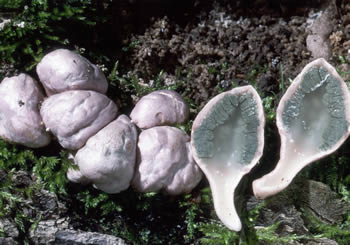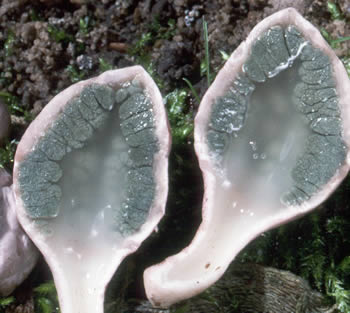Phallogaster saccatus
Scientific name: Phallogaster saccatus Morgan
Derivation of name: Sacc- means "sack" and atus- means
"resembling." Saccatus, then, means "resembling a sack."
Synonyms:
Common name(s): Club-shaped stinkhorn; Stink poke.
Phylum: Basidiomycota
Order: Hysterangiales
Family: Phallogastraceae
Occurrence on wood substrate: Saprobic; solitary or
clustered on decaying wood; May through October.
Dimensions: Fruit body 1-3 cm wide and up to 5 cm tall.
Description: This stinkhorn resembles a small puffball when
young and is pear-shaped (narrowed toward the base) or
nearly globose when mature. It is attached to the substrate by
whitish to pinkish mycelial strands (rhizomorphs). The upper
portion is white to pinkish or lilac-tinged and develops irregular
depressions that open to release the spore mass. The internal
tissue is gelatinous with distinct chambers in the upper portion
holding the dark green, slimy, fetid spore masses at maturity.
Edibility: Inedible.
Comments: A longitudinal sectioning this species will reveal
the important
diagnostic internal spore chambers.

Figure 1. Intact and sectioned specimens of Phallogaster
saccatus. Photo © William Roody.

Figure 2. Note the gelatinous internal tissue and the
chambered glebal spore mass. Photo © William Roody.